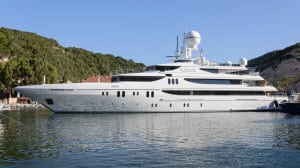HTS Offers Solution to Rising Connectivity Demands at Sea
[Via Satellite 02-27-2015] Noting an uptick in expectation for faster bandwidth in the satellite communications market, NSSLGlobal recently ran a study that found nearly half of all superyacht crewmembers expect to receive the same connectivity speeds at sea as they do on land. With superyachts leading rapidly rising expectations for faster and more reliable maritime connectivity, the question becomes whether or not technology can keep pace.
“Fifty percent of the world’s population is under 30. The younger working-age population has grown up with connectivity as the norm,” Sally-Anne Ray, managing director of NSSLGlobal told Via Satellite. “Increasingly ‘IT-savvy’ crew expects to always be online, which results in a demand for increased speed as well as different ways of using bandwidth.”
With bandwidth previously used primarily for voice and email communications to keep in touch with loved ones while abroad, in just a few short years these demands have been replaced with the desire to access applications such as Facebook, Skype, Whatsapp and FaceTime, all of which are “potentially bandwidth-hungry” applications.
Solutions such as Kerio Control or NSSLGlobal’s Cruise Control can help yacht operators ensure that bandwidth isn’t being wasted while companies improve equipment onboard to try to meet demand. Meanwhile, crewmembers can turn off automatic updates and synching while on board to prioritize bandwidth. But with superyacht owners who have more resources available — often setting the tone for the rest of the industry — it’s likely other vessels will come to demand more reliable connectivity at sea as well, calling for a more permanent solution.
“We definitely believe that demand in the superyacht sector will ripple out to the rest of the maritime community,” Ray said. “This is especially true of commercial maritime where the introduction of the Maritime Labor Convention (MLC-2006), which establishes minimum working and living standards for all seafarers, has meant vessels must re-evaluate their bandwidth.” Passengers aboard cruise ships also often expect similar standards at sea as on land, and support vessels for offshore oilrigs have high bandwidth requirements as well.
Providing this kind of bandwidth at sea where vessels are constantly on the move isn’t easy, however. Speaking to Via Satellite, Capucine Farigier, a consultant and maritime communications expert at Euroconsult, noted that bandwidth and coverage limitations mean that satellite connectivity over oceans isn’t yet comparable to terrestrial fiber networks. Companies such as MTN Communications and Harris CapRock have created hybrid solutions to tap into terrestrial options when available. Farigier notes that while Mobile Satellite Services (MSS) provide global coverage, the bandwidth provided onboard vessels remains limited compared to Fixed Satellite Services (FSS), which are confined to specific regional footprints.
As the industry bumps up against these boundaries, High-Throughput Satellites (HTS) could provide the answer to meeting climbing expectations.
“Technology is progressing fast, especially with the upcoming launch of several HTS systems, such as Inmarsat’s Global Xpress or Intelsat’s EpicNG, which are expected to bring 10 times more capacity than traditional FSS satellite,” Farigier said. “HTS systems are expected to significantly increase available bandwidth per vessel and the coverage over oceans, consequently enabling a new range of applications for end users over the coming years.”
These new possible applications could include roaming, live television, video transmission and e-commerce to keep the crew entertained and connected with life on land. But HTS could also enable business and well-being applications, such as cloud computing or e-training and telemedicine. Additionally, HTS is bringing the Internet of Things (IOT) out to sea, which would improve overall navigation operations.
Moreover, in line with keeping pace with rising expectations, the new capabilities that HTS is bringing to the maritime market may mean that vessels can offer connectivity more cheaply in the long run, which may further stimulate the market.
“In addition to the vast new range of applications that HTS systems should enable, other impacts of these systems will most likely include a decreasing price per Mbps, a decrease in hardware prices, and ultimately new maritime VSAT markets that would have historically not been addressable for satellite providers,” said Farigier. “The competitive market landscape is going to change and potential [Merger and Acquisition] M&A activities will happen partly due to the push from new generation HTS.”
